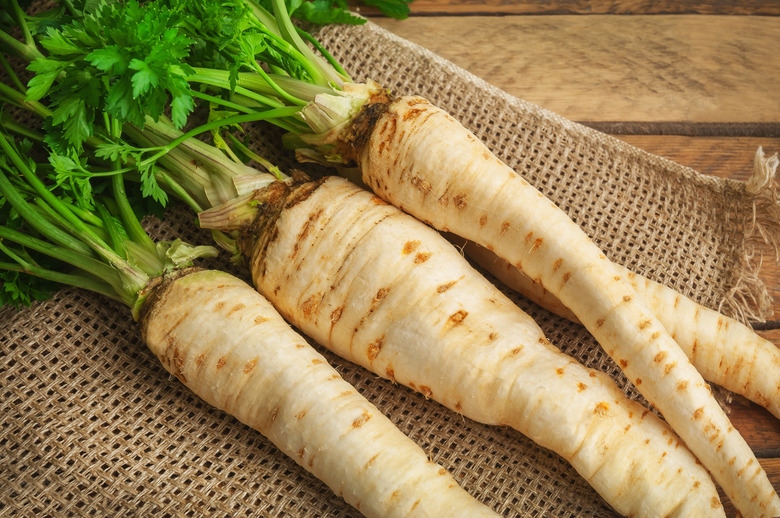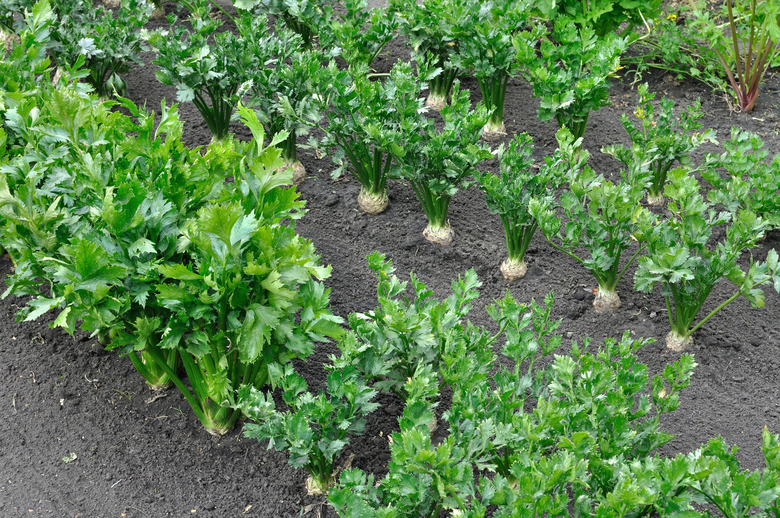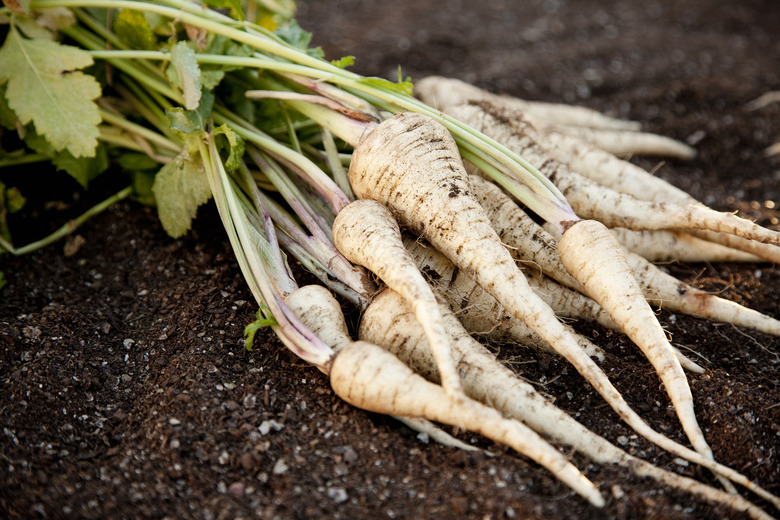How To Grow Parsnips
You just can't rush a parsnip (Pastinaca sativa). These rich but sweet root vegetables do everything in their own time, from germinating to reaching full maturity, and they simply will not be rushed. They need all summer to grow and produce their best flavor when left in the ground well into the fall season.
Unfortunately, parsnip seeds can prove to be persnickety about whether or not they germinate. If yours turn out to be a bust, you won't have another shot at parsnips this year because of their long growing season. The rich, complex flavor of the parsnip is well worth trying again next year with a fresh batch of seeds, however.
Best Uses for Parsnips
Best Uses for Parsnips
Parsnips may not be the belle of the vegetable ball, but more attention should be paid to these earthy, woody, root vegetables that taste like a combination of a carrot and a potato. When growing parsnips, the bulk of the action takes place below the ground where you can't see it. Their leaves resemble those of carrots and are not particularly beautiful, but gardeners don't plant parsnips for their looks. They are used solely as a food crop.
Rich and flavorful, parsnips taste excellent when sautéed on their own with a few garden herbs. They are also excellent for punching up a bland soup, taking your mashed potato game up a notch or stuffing into the turkey alongside carrots and celery every Thanksgiving.
How to Grow Parsnips
How to Grow Parsnips
Starting Parsnips From Seed
Starting Parsnips From Seed
As is true of most root vegetables, it is best to sow your parsnip seeds directly in the ground when the time is right. Don't start your seeds indoors and then transplant them later, as doing so can damage the very roots you are hoping to harvest. It is also important to use only fresh seed when planting parsnips. The seeds don't age well and usually are not viable from one planting season to the next. Here's how to grow parsnips from seeds:
- Wait to plant until the soil temperature in your area warms to 52 degrees Fahrenheit.
- Before sowing your seeds, work the soil to at least a foot deep, removing any rocks or debris as you go. Parsnips don't push past rocks or compacted soil well. The roots will instead stay short, split or grow at an odd angle.
- If your soil is heavy, work in some organic matter, such as compost or peat moss, to keep it looser and to improve drainage.
- Plant your parsnip seeds about 1/4 inch deep, spacing 2 seeds per inch. You may need to thin the seedlings later to one every 6 inches, but you can place seeds close together now. Even in a good batch, up to 60 percent of your parsnip seeds can fail. This is why the spacing isn't critical until you can see how many plants you actually have.
- Gently water your seeds immediately after planting and keep the soil around them evenly moist until they germinate. Seedlings should emerge in two to three weeks.
Tip
Some growers make a hole 2 feet deep for their parsnips and then fill the hole with sand before planting. This method works well if you are growing only a handful of parsnips, but it is time consuming when you are growing a larger number of plants. Most gardeners find it easier to simply amend a large patch of the soil before planting.
In What Zone Do Parsnips Grow Best?
In What Zone Do Parsnips Grow Best?
Technically, the parsnip is a biennial plant that takes two years to complete its life cycle. In the United States, however, most gardeners grow parsnips as an annual plant throughout USDA zones 4 through 8.
You can overwinter parsnips if you properly prepare them for the cold. If you do, you will want to harvest them as early as you can in the spring before they bolt.
When Should You Plant Parsnips?
When Should You Plant Parsnips?
Parsnips have a lengthy 100- to 120-day growth cycle, so plant them as early as you can. For many gardeners, this means planting early in the spring as soon as the soil is workable and maintains a temperature of at least 52 degrees.
Parsnips prefer a maximum air temperature of 75 degrees and grow best in areas with cool summers. If you live in the South where summer temperatures soar, plant your parsnips in the fall or winter rather than in the spring.
Soil, Sunlight, and Water Recommendations for Parsnips
Soil, Sunlight, and Water Recommendations for Parsnips
|
Soil |
Sunlight |
Water |
|
Loamy; pH level between 6.0 and 8.0 |
Full sun, but will tolerate partial |
1 inch of water weekly during growing season |
The perfect home for a parsnip is in deep, loamy soil that is slightly acidic at a pH level between 6.0 and 8.0. When your parsnips reach a height of about an inch, thin them to 6 inches apart.
Parsnips need about 1 inch of water weekly during the growing season. You will have to step up if nature fails to provide adequate rainfall, but do so carefully. Parsnips are a root crop, so it is important that they get long, soaking waterings that reach deeply into the soil. A quick hit with the garden hose is not enough to keep parsnips happy. For bigger vegetables, use a soaker hose or drip irrigation system.
Weeds overwhelm young parsnips quickly, so mulch around your plants and be diligent about your weeding schedule. Weeds are not as problematic once the plants are well established, but they will compete readily with young parsnips for water and nutrients.
Always wear gloves when working with and around your parsnips. Although it is rare, the right combination of parsnip sap, water and light can cause a reaction resulting in burnt and blistered skin.
How to Winterize Parsnips
How to Winterize Parsnips
Because parsnips are technically a biennial plant, it is possible to keep them over the winter. Parsnips actually taste sweeter after enduring a few touches of frost. Frozen ground will kill parsnips, however, so you will need to keep the soil around them as warm as you can. To do so, overwinter your parsnips by covering them with 6 to 10 inches of straw mulch.
If you leave your parsnips in the ground for the winter, harvest them as soon as you can work the soil in the spring. If left too long, parsnips will go to seed and lose their sweet taste.
How to Harvest Parsnips
How to Harvest Parsnips
Parsnips are ready to harvest 100 to 120 days after planting. When it is time, the leaves on your parsnips will let you know by starting to die back. You can then harvest the parsnips by loosening the soil around them and gently pulling them out of the ground. You can break parsnip roots during harvest, so make sure you always loosen the soil before you start pulling or lifting.
It is best to simply leave your parsnips in the ground until you are ready to use them. If you want to store them indoors, however, fill a box with moist soil or sand and store the parsnips in it. You can then store them up to four months in a cool place with low humidity, like an unheated garage or shed.
Common Pests and Other Problems for Parsnips
Common Pests and Other Problems for Parsnips
Like most other plants, parsnips have their fair share of common pests and other issues. Here are some pests to watch out for on your parsnip plant:
- Caterpillars, aphids, and slugs. These bugs often find their way to parsnips but are easy to control. You can easily pick caterpillars off your plants by hand, and you can get rid of aphids with a blast of water from the hose.
- Carrot root flies. These are metallic-looking flies that move fast and are hard to catch. Prevention is the best way to combat them, and some gardeners swear that planting alliums like garlic or chives nearby will do the trick.
Tip
A surprising number of folk remedies do work well in gardens, but if you prefer a more scientific approach to battling carrot root flies, rotate your parsnip crops every year and use row covers if you expect issues with carrot root flies. You can also build a frame around your parsnips and cover it with window screening.
Common Diseases for Parsnips
Common Diseases for Parsnips
Parsnip canker is the most prominent parsnip disease. Caused by a fungus, parsnip canker first appears as a brown spot where the plant's root and leaves meet. Eventually, the plant's leaves will deteriorate, sprouting brown lesions with a green outline.
The best way to control parsnip canker and other fungal diseases is to allow plenty of air circulation around your plants, rotate your crops each year and direct water at the plant's roots rather than its leaves when irrigating. You can also plant the 'Tender and True' parsnip cultivar, which resists parsnip canker. You can use a chemical fungal treatment if necessary.
Tip
Parsnips are also susceptible to rots and bacteria that can affect all leafy plants. You can avoid most problems with basic garden hygiene, such as cleaning up old plant materials, spacing plants properly and staying out of the garden when it is wet. Again, chemical treatments can help when necessary. Consult with your local garden center before going this route so you can get specific information about problems and their cures in your area.


